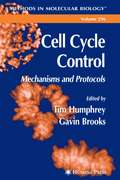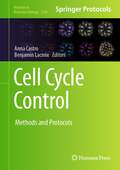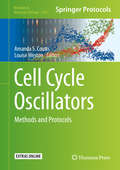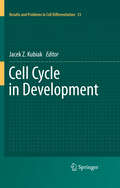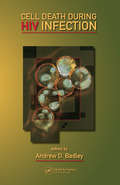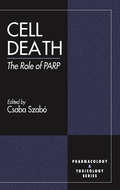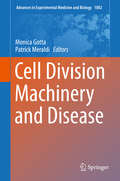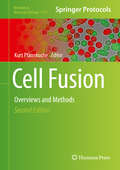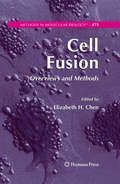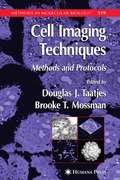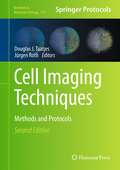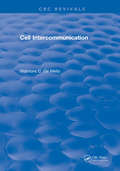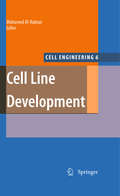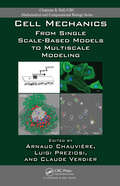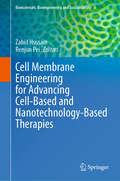- Table View
- List View
Cell Cycle Control: Mechanisms and Protocols (Methods in Molecular Biology #296)
by Gavin Brooks Tim HumphreyThis collection of cutting-edge techniques for the study of the eukaryotic cell cycle and its key regulatory molecules includes overviews of cell cycle regulatory mechanisms in many major research organisms. Described in step-by-step detail, these readily reproducible methods enable fundamental research on well-defined cell cycle regulators-and those more recently defined-in yeasts, bacteria, plants, Drosophila, Xenopus, and mammals. The book offers all cell researchers indispensable techniques essential to understanding how normal cells divide and how this is altered in disease.
Cell Cycle Control: Methods and Protocols (Methods in Molecular Biology #2740)
by Anna Castro Benjamin LacroixThis detailed volume collects techniques to study the highly regulated cell cycle process. Beginning with chapters investigating these processes and assessing how cells respond when these complicated pathways are simplified by using synthetic biology and in vitro reconstitutions, the book continues by exploring how cells sense and respond to environmental conditions, different model systems and cellular types used to visualize cellular architecture during cell division, as well as innovative single cell microscopy techniques to highlight the heterogeneity of the cell population with respect to cell cycle progression. Written for the highly successful Methods in Molecular Biology series, chapters include introductions to their respective topics, lists of the necessary materials and reagents, step-by-step and readily reproducible laboratory protocols, and tips on troubleshooting and avoiding known pitfalls. Authoritative and practical, Cell Cycle Control: Methods and Protocols serves as an ideal guide for researchers attempting to elucidate this vital area of cell biology.
Cell Cycle Oscillators: Methods and Protocols (Methods in Molecular Biology #1342)
by Amanda S. Coutts Louise WestonThis volume brings together a unique collection of protocols that cover standard, novel, and specialized techniques. Cell Cycle Oscillators: Methods and Protocols guides readers through recent progress in the field from both holistic and reductionist perspectives, providing the latest developments in molecular biology techniques, biochemistry, and computational analysis used for studying oscillatory networks. Written in the highly successful Methods in Molecular Biology series format, chapters include introductions to their respective topics, lists of the necessary materials and reagents, step-by-step, readily reproducible laboratory protocols, and tips on troubleshooting and avoiding known pitfalls. Authoritative and cutting-edge, Cell Cycle Oscillators: Methods and Protocols will serve as an invaluable reference to gain further insight into the complex and incompletely understood processes that are involved in the cell cycle and its regulation by oscillatory networks.
Cell Cycle Oscillators: Methods and Protocols (Methods in Molecular Biology #2329)
by Amanda S. Coutts Louise WestonThis book brings together a unique collection of protocols that cover novel and specialized techniques as well as updated and improved adaptations of more standard procedures involving the cell cycle and its regulation by oscillatory networks, exploring recent progress in the field from both holistic and reductionist perspectives. The edition provides a space for researchers to highlight and explore the latest developments in molecular biology and biochemical techniques for studying oscillatory networks and to share these across the research community to facilitate further progress. Written in the highly successful Methods in Molecular Biology series format, chapters include introductions to their respective topics, lists of the necessary materials and reagents, step-by-step, readily reproducible laboratory protocols, and tips on troubleshooting and avoiding known pitfalls. Authoritative and up-to-date, Cell Cycle Oscillators: Methods and Protocols, Second Edition serves as an invaluable guide for those new to the field as well as the more experienced scientist.Chapter 19 is available open access under a CC BY 4.0 license.
Cell Cycle Regulation and Development in Alphaproteobacteria
by Emanuele BiondiThis book provides a comprehensive overview of the cell cycle regulation and development in Alphaproteobacteria. Cell cycle and cellular differentiation are fascinating biological phenomena that are highly regulated in all organisms. In the last decades, many laboratories around the world have been investigating these processes in Alphaproteobacteria. This bacterial class comprises important bacterial species, studied by fundamental and applied research. The complexity of cell cycle regulation and many examples of cellular differentiations in this bacterial group represent the main motives of this book. The book starts with discussing the regulation of cell cycle in alphaproteobacterial species from a system biology perspective. The following chapters specifically focus on the model species Caulobacter crescentus multiple layers of regulation, from transcriptional cascades to proteolysis and dynamic subcellular regulation of cell cycle regulators. In addition, the cell division process, chromosome segregation and growth of the cell envelope is described in detail. The last part of the book covers examples of non-Caulobacter alphaproteobacterial models, such as Agrobacterium tumefaciens, Brucella species and Sinorhizobium meliloti and also discusses possible applications. This book will be of interest to researchers in microbiology and cell biology labs working on cell cycle regulation and development.
Cell Cycle Synchronization: Methods and Protocols (Methods in Molecular Biology #1524)
by Gaspar BanfalviTo prepare synchronized cells representing different stages of the cell cycle has been a great challenge for researchers across the globe. In Cell Cycle Synchronization: Methods and Protocols, experts in the field supply detailed protocols providing first the theoretical background of the procedure then step-by-step instructions on how to implement synchronization as well as the latest techniques for the enhanced study of regulatory mechanisms to understand cell cycle events. Describing synchronized cells from asynchronous bacterial, plant, protozoan, yeast, fish, and mammalian cell cultures, the synchronization methods presented in the book are based principally on two major strategies: the "arrest-and-release" approach, which involves different chemical treatments to block cells at certain stages of the cell cycle, and the physical strategy, which contains physical methods to collect cells belonging to subpopulations of the cell cycle. Written in the highly successful Methods in Molecular Biology(tm) series format, chapters include introductions to their respective topics, lists of the necessary materials and reagents, step-by-step, readily reproducible laboratory protocols, and tips on troubleshooting and avoiding known pitfalls. Detailed and easy to follow, Cell Cycle Synchronization: Methods and Protocols is an ideal guide for scientists who wish to make use of these powerful synchronization techniques but have no access to thorough, time-tested protocols designed for doing so.
Cell Cycle Synchronization: Methods and Protocols (Methods in Molecular Biology #761)
by Gaspar BanfalviTo prepare synchronized cells representing different stages of the cell cycle has been a great challenge for researchers across the globe. In Cell Cycle Synchronization: Methods and Protocols, experts in the field supply detailed protocols providing first the theoretical background of the procedure then step-by-step instructions on how to implement synchronization as well as the latest techniques for the enhanced study of regulatory mechanisms to understand cell cycle events. Describing synchronized cells from asynchronous bacterial, plant, protozoan, yeast, fish, and mammalian cell cultures, the synchronization methods presented in the book are based principally on two major strategies: the "arrest-and-release" approach, which involves different chemical treatments to block cells at certain stages of the cell cycle, and the physical strategy, which contains physical methods to collect cells belonging to subpopulations of the cell cycle. Written in the highly successful Methods in Molecular BiologyTM series format, chapters include introductions to their respective topics, lists of the necessary materials and reagents, step-by-step, readily reproducible laboratory protocols, and tips on troubleshooting and avoiding known pitfalls. Detailed and easy to follow, Cell Cycle Synchronization: Methods and Protocols is an ideal guide for scientists who wish to make use of these powerful synchronization techniques but have no access to thorough, time-tested protocols designed for doing so.
Cell Cycle in Development (Results and Problems in Cell Differentiation #53)
by Jacek Z. KubiakThis book focuses on the intersection between cell cycle regulation and embryo development. Specific modifications of the canonical cell cycle occur throughout the whole period of development and are adapted to fulfil functions coded by the developmental program. Deciphering these adaptations is essential to comprehending how living organisms develop. The aim of this book is to review the best-known modifications and adaptations of the cell cycle during development. The first chapters cover the general problems of how the cell cycle evolves, while consecutive chapters guide readers through the plethora of such phenomena. The book closes with a description of specific changes in the cell cycle of neurons in the senescent human brain. Taken together, the chapters present a panorama of species - from worms to humans - and of developmental stages - from unfertilized oocyte to aged adult.
Cell Death During HIV Infection
by Andrew D. BadleyIn an effort to go beyond immune-based therapies, researchers are now considering the implications of apoptosis dysregulation during HIV-induced immunodeficiency. This work provides the first comprehensive compendium of the progress made in understanding the process of cell death related to HIV and the potential breakthroughs in treatment that offer much promise. Combining the work of more than two-dozen top researchers, this seminal volume provides clinicians and researchers with an excellent reference, while also serving as an incubator to stimulate future research. It explains the fundamental biology involved with apoptosis, explains its clinical impact in HIV, and examines the newest therapeutic approaches.
Cell Death Signaling in Cancer Biology and Treatment (Cell Death in Biology and Diseases #1)
by Daniel JohnsonA key goal in the treatment of cancer is to achieve selective and efficient killing of tumor cells. The aim of Cell Death Signaling in Cancer Biology and Treatment is to describe state-of-the-art approaches and future opportunities for achieving this goal by targeting mechanisms and pathways that regulate cancer cell death. In this book, molecular defects in cell death signaling that characterize cancer cells, including dysregulation of cell death due to overexpression/hyperactivation of oncoproteins, as well as the loss of tumor suppressor proteins will be described. The potential for targeting microRNAs will be discussed. Multiple chapters will describe preclinical and clinical approaches that are currently being used to target epigenetic modifications, DNA repair pathways, and protein chaperones, as a means of provoking tumor cell death. Finally, the development and application of novel agents and approaches for targeting specific components of cell death signaling pathways and machinery will be reviewed.
Cell Death: Mechanism and Disease
by Hao WuBeginning from centuries of anecdotal descriptions of cell death, such as those on the development of the midwife toad in 1842 by Carl Vogt, to modern-day investigations of cell death as a biological discipline, it has become accepted that cell death in multicellular organisms is a normal part of life. This book provides a comprehensive view of cell death, from its mechanisms of initiation and execution, to its implication in human disease and therapy. Physiological cell death plays critical roles in almost all aspects of biology, and the book details its roles in lymphocyte homeostasis, neuronal function, metabolism, and the DNA damage response. When physiological cell death goes awry, diseases can arise, and cancer is presented as a central paradigm for the consequences of derangements in the interplay between cell survival and cell death. At the same time, the potential promise of targeted therapies aimed at interdicting cell death machineries are also discussed extensively. The molecular mechanisms that underlie apoptotic cell death are illustrated from the perspectives of both the intrinsic, mitochondrial apoptotic pathway and the extrinsic, death receptor pathway. Key players in these pathways, such as the Bcl2 family proteins, cytochrome c, Apaf-1, caspases, death receptor adapter proteins, and inhibitor of apoptosis proteins, are presented from both functional and structural angles. Until only a few years ago, programmed cell death has been considered essentially synonymous with apoptosis. However, we now know that programmed cell death can also take other forms such as necrosis or necroptosis, and to this end, the mechanisms that underlie programmed necrosis in development and host defense are illustrated. The past twenty plus years have seen an incredible growth of research in cell death, with one breakthrough after another, and the legacy still goes on with constant new surprises and findings. Long live cell death!
Cell Death: The Role of PARP (Handbooks in Pharmacology and Toxicology)
by Richard CrowsonPoly (ADP-ribose) polymerase (PARP), also termed poly (ADP-ribose) synthetase (PARS) is a nuclear enzyme with a wide range of functions, including regulation of DNA repair, cell differentiation, and gene expression. More than a decade after the identification of PARP-like enzymatic activities in mammalian cells, a novel role was proposed for this e
Cell Division Machinery and Disease (Advances in Experimental Medicine and Biology #1002)
by Monica Gotta Patrick MeraldiThis book critically evaluates the causal link between cell division machinery and disease. Further, it identifies key open questions in the field and the means for exploring them. Throughout the various chapters, internationally known contributors present the evidence for and against a causal link between key elements of the cell division machinery and diseases such as cancer, neuropathologies, aging, and infertility. A more clinically oriented chapter further discusses the current and future applications of anti-mitotic drugs in these diseases. Cell Division Machinery and Disease is essential reading for graduate or advanced graduate students, researchers or scientists working on cell division as well as clinicians interested in the molecular mechanisms of the discussed diseases.
Cell Electrophoresis
by Johann BauerThis book presents a summary of the application and instrumentation of cell electrophoresis. The method of making cell purification and characterization possible according to the cellular negative surface charge density is discussed, and ideas for future developments are explained. The negative electrostatic forces at cell surfaces provide information about cell-cell interaction, blood vessel sealing, cytokine actions, cell transformation, ion transport phenomena, and other biological phenomena. Recalculations of the physical principles of cell electrophoresis reveal possibilities for removing disruptive factors caused by electrical current, heat, and sedimentation. The introduction of computer technology, the performance of simultaneous two-parameter measurements, and the application of cell-friendly but current-inert buffer systems render the method more reliable and efficient.
Cell Fusion in Health and Disease: II: Cell Fusion in Disease (Advances in Experimental Medicine and Biology #950)
by Thomas Dittmar Kurt S. ZänkerAlthough cell fusion is an omnipresent process in life, to date considerably less is still known about the mechanisms and the molecules being involved in this biological phenomenon in higher organisms. In Cell Fusion in Health and Disease Vol 1 & Vol 2 leading experts will present up-to-date overviews about cell fusion in physiological and patho-physiological processes, which further covers the current knowledge about cell fusion-mediating molecules. Volume 1 deals with Cell Fusion in Health and will cover aspects of cell fusion in fertilization, placentation, in C. elegans, in skeletal muscle development and tissue repair, and the use of cell fusion for cellular reprogramming and cancer vaccine development. Volume 2 focuses on Cell Fusion in Disease with a particular emphasis on the role of cell fusion in cancer development and progression. Thus, Cell Fusion in Health and Disease Vol 1 & Vol 2 represents a state-of-the-art work for researchers, physicians or professionals being interested in the biological phenomenon of cell fusion and beyond.
Cell Fusion: Overviews and Methods (Methods in Molecular Biology #1313)
by Kurt PfannkucheThis volume details protocols on detection and analysis of fusion events in various cell types in vitro and in vivo. Additional, protocols aim to facilitate the future highly relevant process of engineering cells for specific purposes, such as generation of transgenic embryos and development of hybrid cells, in order to tackle specific tasks in cell biology and medicine. Written for the Methods in Molecular Biology series, chapters include introductions to their respective topics, lists of the necessary materials and reagents, step-by-step, readily reproducible laboratory protocols, and tips on troubleshooting and avoiding known pitfalls. Practical and authoritative, Cell Fusion: Overviews and Methods, Second Edition serves as an ideal reference on cell fusion and laboratory protocols.
Cell Fusion: Overviews and Methods (Methods in Molecular Biology #475)
by Elizabeth H. ChenExciting work in the past decade has revealed commonalities and differences among individual cell fusion events. In Cell Fusion: Overviews and Methods, a team of leading experts provide a collection of overviews that outline our current understanding of cell fusion and methods that present classic and state-of-the-art experimental approaches in a variety of systems. Divided into two convenient parts, the volume begins with nine overviews which describe different cell fusion events in models from yeast to mammals, and it continues with thirteen chapters illustrating commonly used methods to assay cell fusion in particular systems. As a part of the highly successful Methods in Molecular BiologyTM series, these methods chapters compile step-by-step, readily reproducible protocols with lists of the necessary materials and reagents, along with tips on troubleshooting and avoiding known pitfalls. Cutting-edge and user-friendly, Cell Fusion: Overviews and Methods serves as a comprehensive resource for anyone, expert or novice, interested in the fascinating biological process of cell fusion.
Cell Imaging Techniques: Methods And Protocols (Methods in Molecular Biology #319)
by Douglas J. Taatjes Brooke T. MossmanA diverse collection of state-of-the-art methods for the microscopic imaging of cells and molecules. The authors cover a wide spectrum of complimentary techniques, including such methods as fluorescence microscopy, electron microscopy, atomic force microscopy, and laser scanning cytometry. Additional readily reproducible protocols on confocal scanning laser microscopy, quantitative computer-assisted image analysis, laser-capture microdissection, microarray image scanning, near-field scanning optical microscopy, and reflection contrast microscopy round out this eclectic collection of cutting-edge imaging techniques now available. The authors also discuss preparative methods for particles and cells by transmission electron microscopy.
Cell Imaging Techniques: Methods and Protocols (Methods in Molecular Biology #931)
by Douglas J. Taatjes Jürgen RothCell Imaging is rapidly evolving as new technologies and new imaging advances continue to be introduced. In the second edition of Cell Imaging Techniques: Methods and Protocols expands upon the previous editions with current techniques that includes confocal microscopy, transmission electron microscopy, atomic force microscopy, and laser microdissection. With new chapters covering colocalization analysis of fluorescent probes, correlative light and electron microscopy, environmental scanning electron microscopy, light sheet microscopy, intravital microscopy, high throughput microscopy, and stereological techniques. Written in the highly successful Methods in Molecular BiologyTM series format, chapters include introductions to their respective topics, lists of the necessary materials and reagents, step-by-step, readily reproducible laboratory protocols, and tips on troubleshooting and avoiding known pitfalls Authoritative and cutting-edge, Cell Imaging Techniques: Methods and Protocols, Second Edition is an easily accessible volume of protocols to be used with a variety of imaging-based equipment likely available in a core imaging facility.
Cell Interactions in Atherosclerosis
by Horst Robenek Nicholas J. SeversCell Interactions in Atherosclerosis covers the scientific foundations of the most important disease inflicting the developed world today. It presents a collection of topical aspects on the general theme of cell interactions in atherosclerosis, providing authoritative, up-to-the-minute accounts of how new developments in cell biology have advanced our understanding of these cellular interactions. The book is amply illustrated with electron micrographs and light micrographs incorporating modern cytochemical procedures. Cell Interactions in Atherosclerosis will interest all medical and scientific professionals dealing with atherosclerosis and heart disease.
Cell Intercommunication
by Walmore C. De MelloThis important publication addresses intercellular communication in health and disease. It includes recent advances in morphology and chemical organization of gap junctions. It discusses the possible role of intercellular channels in excitable and non-excitable tissues. The book presents modulation of junctional permeability, as well as the possible role of cell communication in embryonic development and growth. The text concludes with a synthetic view of the role of gap junctions and potential implications to cardiology, oncology, and other areas of pathology. This volume is important to professionals in pharmacology, physiology, biochemistry, biomedical science, pathobiology, pathology, molecular genetics, toxicology and human development.
Cell Invasion
by Jyrki HeinoProvides an overview of cell invasion. Topics include information on the cellular matrix, cell surface integrins, matrix metalloproteinases and proteinases, and the interplay between protein families.
Cell Line Development (Cell Engineering #6)
by Mohamed Al-RubeaiMammalian cell lines command an effective monopoly for the production of therapeutic proteins that require post-translational modifications. This unique advantage outweighs the costs associated with mammalian cell culture, which are far grater in terms of development time and manufacturing when compared to microbial culture. The development of cell lines has undergone several advances over the years, essentially to meet the requirement to cut the time and costs associated with using such a complex hosts as production platforms. This book provides a comprehensive guide to the methodology involved in the development of cell lines and the cell engineering approach that can be employed to enhance productivity, improve cell function, glycosylation and secretion and control apoptosis. It presents an overall picture of the current topics central to expression engineering including such topics as epigenetics and the use of technologies to overcome positional dependent inactivation, the use of promoter and enhancer sequences for expression of various transgenes, site directed engineering of defined chromosomal sites, and examination of the role of eukaryotic nucleus as the controller of expression of genes that are introduced for production of a desired product. It includes a review of selection methods for high producers and an application developed by a major biopharmaceutical industry to expedite the cell line development process. The potential of cell engineering approch to enhance cell lines through the manipulation of single genes that play important roles in key metabolic and regulatory pathways is also explored throughout.
Cell Mechanics: From Single Scale-Based Models to Multiscale Modeling
by Claude Verdier Arnaud Chauvière Luigi PrezigsiUbiquitous and fundamental in cell mechanics, multiscale problems can arise in the growth of tumors, embryogenesis, tissue engineering, and more. Cell Mechanics: From Single Scale-Based Models to Multiscale Modeling brings together new insight and research on mechanical, mathematical, physical, and biological approaches for simulating the behavior
Cell Membrane Engineering for Advancing Cell-Based and Nanotechnology-Based Therapies (Biomaterials, Bioengineering and Sustainability #6)
by Zahid Hussain Renjun PeiThe battle against complex diseases and tissue defects drives innovation in treatment and medical research. The cell membrane plays a fundamental role in biological processes and serves as a promising platform for diagnostic and therapeutic advancements due to its diverse receptors and ligands. Recent advances in bioengineering, synthetic biology, and biomimetic nanotechnology have enabled the development of engineered cell membrane-based platforms, including surface-engineered cells, extracellular vesicles, bacterial membrane vesicles, membrane-coated nanoparticles, and hybrid nanomaterials, offering improved therapeutic and diagnostic potential over their natural counterparts. This book provides a comprehensive exploration of essential cell surfaceome components, detailing state-of-the-art surface engineering strategies and advancements in engineered cells and membrane-based therapeutic nanoplatforms. It examines the transformative applications of these platforms in immune engineering, gastrointestinal disease management, cancer therapy, tissue engineering, circulating tumor cell capture, theranostics, and the treatment of neurodegenerative, inflammatory, and infectious diseases. Significant topics, many at the forefront of scientific research, are examined in depth, allowing academics, clinicians, and biomedical researchers to understand the latest advancements in cell membrane engineering and address unmet clinical needs. Furthermore, this interdisciplinary book is highly relevant to modern healthcare and provides instructional content for graduate students in <span lang="ZH-CN" style="font-size: 12.0pt; line-height: 150%; font-family: 'Arial',sans-serif; mso-fareast-font-family: Aptos; mso-fareast-theme-font: minor-latin; mso-ansi-language: ZH-CN; mso-fareast-lan
